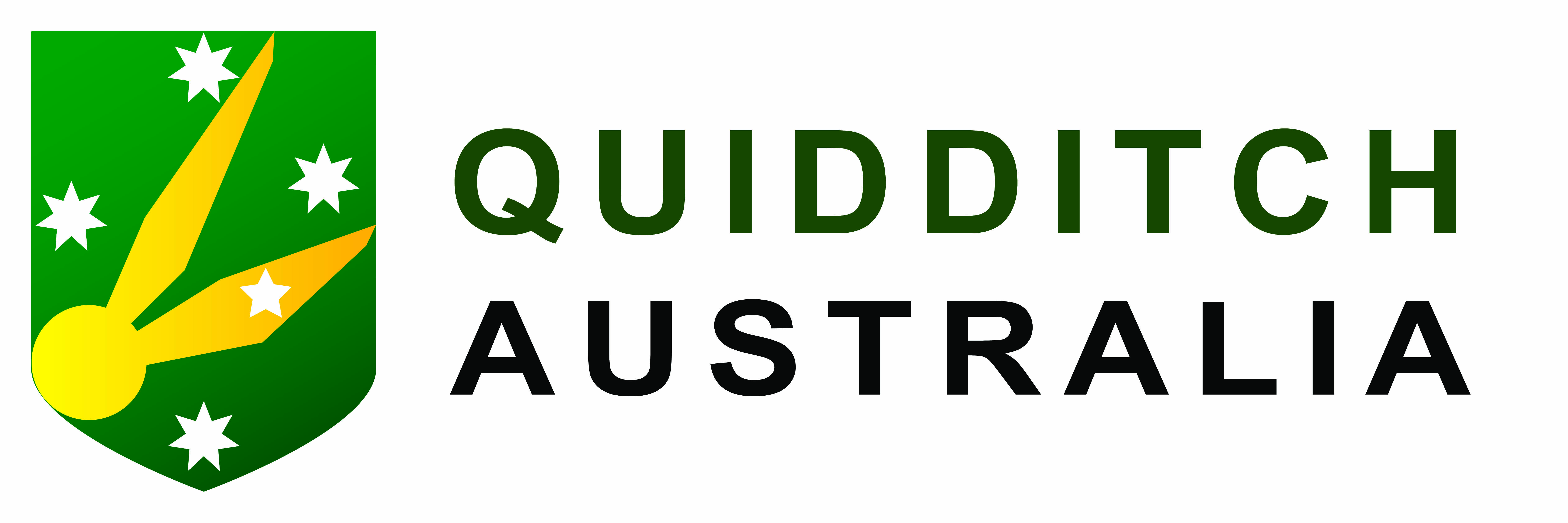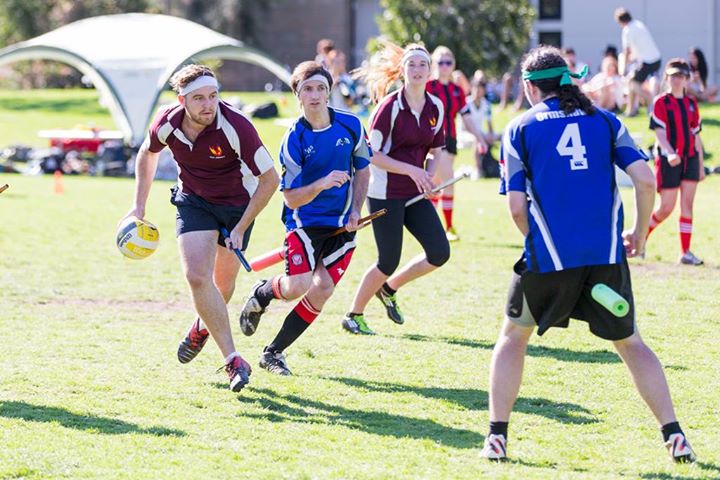NSW QUAFL Preview-October Triwiz Reflection
So somehow another QUAFL is already upon us in less than two weeks, the fourth such converging of Australian quidditch’s best and brightest and the biggest and most bombastic yet. QUAFL 2014 has snuck up as fast as these major events always invariably do, but for NSW teams it will be the next logical step up from what has been a busy and dramatic year of Triwizard action. Since May, nine of NSW and the ACT’s teams have expanded the Triwizard concept to hitherto unthinkable vastness, like one day mini-QUAFLs. For the eight of those teams represented at the National Championships, there can be no better mental preparation for the emotional rigours of a forty-three game twenty-hour extravaganza. But if Triwizard really is about preparation then this year has been absolutely textbook for so many teams, who have shown foreshadowing glimpses of their peak but more often only hinted at the potential present therein.
Photo Credit: Matt Hudson
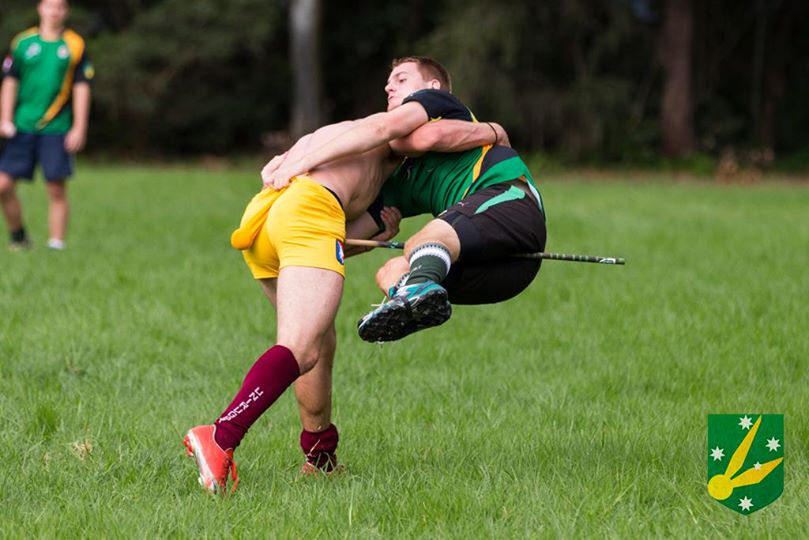
Saying that things are “the same yet different” really is a prominent cliché of mine, amongst many others. Naturally therefore, I will bring it back out here. It’s obviously been a huge year in NSW, full of massive transition for most teams both internally and externally. The Fireballs and Nargles, each months’ farthest visitors to Sydney, have both come back from the near dead with revolutionised and reinvigorated new generation teams. 2013’s raw rookies from the University of Sydney are now as refined as the edifices of their campus, armed with the lessons learned from seeing and facing the best in the world first hand. UNSW’s juggernaut rolls on unabated but defined by the coming of age of their Midwinter Cup-winning humble heroes. UTS have ridden out their early turbulence and might just have come stronger out the other side just in time. UWS and Macquarie have stared resolutely in the face of the changing game, digging their heels with the renewed determination that has always served them well and may be their X factor this coming QUAFL. The “changing game” is the biggest change itself though, for of course, the odd individual in NSW knows how to tackle now!
The 2014 implementation of standardised tackle on a national scale took its time permeating the NSW game in a visible way. Indeed, the beginnings of any kind of polar shift have only just begun to take hold, which is what gives recent Triwizard history that uneasy feel of preparatory incompleteness, leading towards an end game that may follow through at QUAFL. But perhaps the uneasiness is simply the cognitive dissonance that comes from trying to reconcile these supposed notions of change with the fact that results are largely the same as they’ve always been. Look at the facts and numbers involved. As per historical tradition, it’s still UNSW well on top, then UWS, then fresh air. The Snapes and Thestrals remain emphatically clear at the top of the rankings on a state and national level. The game has undeniably changed and continues to shift, but the cream will always rise. The big question is how unobstructed it will find a way to rise to the surface this QUAFL.
The bigger question may just be how buoyant other teams will turn out to be when the anchors of travel, transition and Triwizard in general are lifted. What makes the lurking hint of change most ominous is that QUAFL is where it is mostly likely to come out fully fledged. It happened last year, most notably in the Unspeakables’ unceremoniously unorthodox but clearly concerted deconstructing of the powerhouse UWS unit at its peak. Over the course of the last six months, every NSW team has shown enough evidence of greatness to suggest just how good they could be, but most have reached it all too rarely. QUAFL is where those heights are invariably attained though. Look at the Marauders, much maligned through much of 2013, threatening at October, then the best team of Saturday at QUAFL 2013 and its eventual runners up. Newcastle similarly rose to the occasion, while UNSW and UWS ended a year of total and likely unmatchable dominance by being summarily dumped out before the final four. A single-elimination setup always has an element of chance involved, but it’s no fluke that the chasing pack catches up for this one special time of year.
Entire years before QUAFL are an exercise in misdirection before the true form of QUAFL, when finally each team can both step their fully formed strategies out from the shadows, and pile every oft-absent superstar they can muster back into the fold in one go. UNSW dominate on a month-to-month basis because they are the best team in the country, this is an undeniable fact. But their margin is inflated by the perpetual holes in the collective opposition. It is a deserved and self-inflated margin of course, they benefit from the exemplary attendance they ensure each month without fail. It is a strong and positive culture and for all the deep wells of talent inherent in the rich and powerful Snapes, it will never be a coincidence that Australia’s greatest team is the one which has the greatest stability of attendance within its star players. Through their dedication and professionalism, UNSW also effectively trains and utilises every player of their squad regardless of original ability until each is a well-oiled cog serving a particular role and doing it with inevitable competence. In short, they are the one Australian club whose overall regime is of the American standard, for now.
UWS may lack the depth of UNSW, but they share the total stability within their core, a core which can outrun anyone for pure athleticism and outwit anyone for sheer experience. Ergo, these two teams aren’t just the undeniable best by a medium sized margin, they dominate with such total consistency by minimising monthly fluctuation to such an extent that over a whole year, everyone else is made to look decidedly mediocre. But they aren’t. The Snapes and Thestrals deserve the rewards they’re afforded on the rankings table, but QUAFL is the big one everyone wants and crawls out for. The rankings mean nothing.
Photo Credit: Matt Hudson
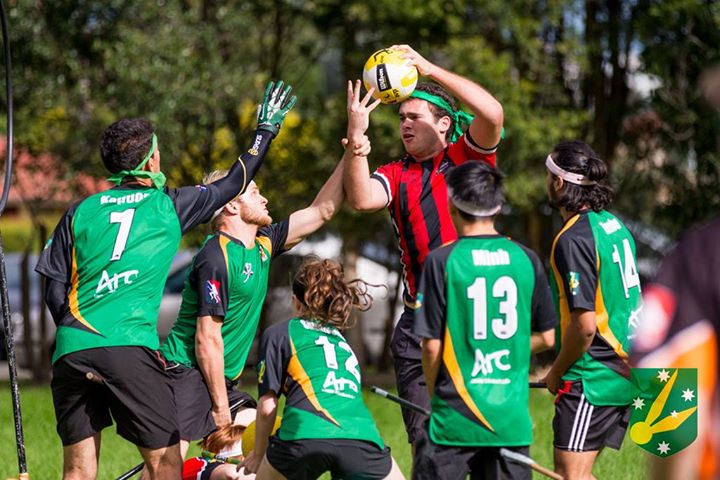
As undisputed as UNSW and UWS’s mathematical supremacy is, evidence of others’ ability to match this standard has been there to see for certain fleeting moments. Newcastle showed at May Triwizard and Midwinter Cup that at their very best they have the sheer firepower to match it with UNSW. They haven’t shown this since, but this is the lot of a team for whom Triwizard each month is a journey from comparatively afar. Midwinter was the last time Newcastle were at home and their squad has been well short in both numbers and names every time since. QUAFL should see a line-up reflective of Midwinter’s but with six months extra experience. Wollongong too struggle enough for numbers without the demands of monthly travel. The last time they presented a close to full strength squad was at home in April and they were crisp, a level they have not been able to match subsequently. The question mark over the Warriors at the moment is whether they will be at full strength for QUAFL. It’s looking unlikely, but if they can get close they will without doubt provide an even greater challenge than their always sturdy structure already does.
What about the Nargles? Their travel demands are downright Herculean. At May Triwizard they were quality but not quite there yet, but this makes sense for a new team. At Melbourne Mudbash they were brilliant in patches but lacked depth, as a team of ten from interstate will tend to. Moving on to August then through to September they incrementally improved, only to miss October. This absence could be crucial; such is the pace of development in NSW quidditch at the moment. But at QUAFL they will have a record squad of nineteen and perhaps for the first time ever, certainly in recent history, a truly full strength squad. But they won’t have it easy as they’ve been drawn alongside UTS in Pool A. Less can be said of UTS than any of these teams, so recent and rapid is their rise. At August they reached their relative nadir, with a small and inexperienced squad losing comfortably against beatable opposition, including to the embryonic Macarthur Weasleys. Another four losses from four in September seemed to mark much of the same, but good opposition and bad luck masked what was clear progress. In October they turned the tables on the Weasleys and further developed a cadre of big, strong and quick new recruits. No major scalp resulted, but they were closer than they’d ever been before and with a monster squad, which is the biggest of any of the thirteen teams in the tournament and contains all their important names, the Opaleyes may just make the biggest quality jump from October to QUAFL of any team.
Think too of the Unspeakables, who brought their strongest squad to September and duly annihilated everything in their path. At October they were weaked by injury, exams and general October apathy. Yet they still outplayed UWS, almost came from behind to stun Newcastle again, managed to frustrate and hold out UNSW like few have before this year, and beat a strong Macquarie outfit. Speaking of that strong Macquarie outfit, it didn’t set the world alight in October as it did last year, but the mere addition of one or two X factors still made a big difference. There was still the firepower shortage they’ve had all year as they could only manage a goal each against the top defences of UNSW and Sydney. But they comprehensively put competitive UTS and Wollongong units to bed. More firepower should be available to them at QUAFL, further boosted by the luxury of playing in their own backyard. Macquarie know how to peak for QUAFL, will be playing at home and will have their biggest and strongest squad since last QUAFL, which they were only two deft Katelyn Stubberfield beats away from winning.
So there is every chance UNSW will fire through eight straight and comfortably win QUAFL, invariably beating the otherwise dominant UWS in the final. The Snapes will have something in hand too, no doubt about that. But instead, maybe Newcastle will steamroll all in their path on the way to glory. Maybe the guile and worldliness of Sydney will take them close, or even all the way, to triumph. Perhaps the rapid Nargles will be swiftly into the Semi Finals before anyone has seen what’s hit them, or the criminally undervalued Opaleyes firmly imbedded in the Quarters, with momentum threatening to push either of them even further still. There is of course many worthy interstate teams to deal with which will make every team’s job infinitely harder. No less a threat than the champion Perth Phoenixes themselves will be present, on top of four class Victorian outfits. There is no real way of knowing where they might fit into the grand scheme of things. The only opportunity for observation was Melbourne Mudbash where the Nargles showed promise and where Sydney largely didn’t, but with a skeleton team that was never going to match their usual standard.
So what’s going to happen? In short, you can clearly see by my vapid meandering that I haven’t the faintest idea! That’s what is great about it. But let’s have an even closer look at October Triwizard to try and get even more of an idea.
Photo Credit: Matt Hudson
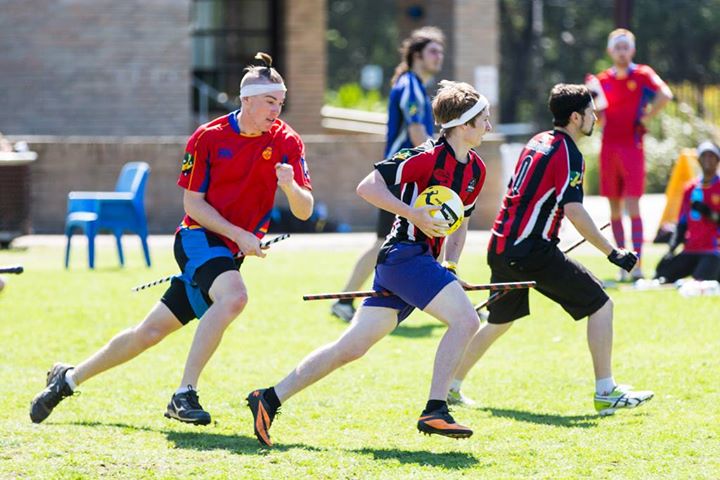
RESULTS
Italics = Unranked Game
| University of Western Sydney | 150* | vs | 10 | Wollongong Warriors |
| University of Technology Sydney | 110* | vs | 50 | Macarthur Weasleys |
| University of Sydney Unspeakables | 60 | vs | 40* | Macquarie Marauders |
| Newcastle Fireballs | 120* | vs | 20 | University of Technology Sydney |
| Wollongong Warriors | 140 | vs | 120* | Macarthur Weasleys |
| University of New South Wales | 120* | vs | 10 | Macquarie Marauders |
| University of Western Sydney | 110* | vs | 70 | University of Sydney Unspeakables |
| University of New South Wales | 130 | vs | 40* | Wollongong Warriors |
| Macquarie Marauders | 100* | vs | 0 | University of Technology Sydney Opaleyes |
| University of Western Sydney | 140* | vs | 50 | Macarthur Weasleys |
| University of New South Wales | 130* | vs | 10 | University of Technology Sydney Opaleyes |
| Newcastle Fireballs | 110* | vs | 70 | University of Sydney Unspeakables |
| Macquarie Marauders | 90* | vs | 10 | Wollongong Warriors |
| University of Western Sydney | 130* | vs | 90 | Newcastle Fireballs |
| University of New South Wales | 80* | vs | 0 | University of Sydney Unspeakables |
Just like the rankings as a whole, a quick glance at the scores this particular month tells you all you need to know who the best teams are, but nowhere near enough to understand just how much the pack has tightened compared to the sparse days of March. Make no mistake, virtually every game was controlled for the bulk of its duration by one clear front-runner. But no game all day visually looked or felt like the kind of truly one-sided affair that is often seen. The closest anyone came to comprehensively thrashing another side was UWS in the very first game against Wollongong. But even then, they scored only twice in the first eight minutes and inflated the margin late with their superior fitness and unfailing ability to find an extra gear when the mood behoves them. UNSW no doubt could have put up a domineering display aswell but with their Warrior clash unranked, they used the opportunity to give a run to some under-done relief players.
The rest of the day was defined by a consistent pattern, whereby one team would always look the likely winner while the other found methods and fight to keep the contest alive in spite of itself. Sydney fired out of the blocks against Macquarie but could not extend on their early 20-0 lead as the increasingly well-oiled Kieran Richards led Marauder defence buffed up its shiny shields. The Unspeakables found that pace wasn’t doing the job and without backup size behind him, the otherwise stellar Nicholas Albornoz was being left in the lurch. In the end it took the shifting of captain Luke Derrick out of beating to give some muscle to the chaser line-up and for Macquarie to finally be put just about away. They still only won by twenty though thanks to Daniel Commander’s snitch catch. The twin threat of either Commander or the new energy efficient model Leslie Fox to go after snitches, alternating and keeping each other fresh, is no doubt the Marauders’ X Factor. Their challenge will be to keep everyone within thirty points, but if they do, look out.
Newcastle vs UTS followed a similar profile, but without the fast start. A third minute James Mortensen solo burst was the only score for the entire first ten minutes. The Opaleyes rarely had bludger control and never looked the better team, but they just would not go away. It took fifteen minutes and a wholesale tactical shake-up just for the theoretically short priced favourites to get out of snitch range. They drew away from this point but 120-20 in twenty-one minutes, itself a tighter margin than many may have expected, was still wider than UTS deserved.
Nothing through the middle of the day quite so perfectly lived up to the ‘front-runner vs fighter’ profile. UTS didn’t quite have the same fight against Macquarie, though 100-0 was an eye-catching scoreline for the impressive Marauders, particularly the 0 part. UNSW continued to sweep all before them, but with one notable exception. Late in the afternoon, with the very last match, the day’s theme came dramatically full circle. The Snapes dominated early and quickly led 20-0, over the Unspeakables. But recognising the nature of the opposition and of the limitations presented by their own mere ten person squad in its fourth game of the day, Sydney dug their heels in, along with their shins, hips and half of their chest. A more comprehensive and positively Kansastrian slow-balling has not been seen in Australian quidditch. Macquarie had some good results with the strategy way back in April, initially conceding a dozen goals at one per minute before slowing the game down completely and limiting UNSW to just two more over the equivalent second half of the match. To my constant surprise, no team has since taken up this defensive possession tactic, for the best way to stop UNSW beating you at quidditch as they rightfully will is to not let them play it. Perhaps it is the noble morality in Australia’s gorgeous quidditch community that does not allow such negativity to permeate most teams’ game. But the Unspeakables have never been bothered with niceties so had no concern with bringing out the slow-ball. It was highly effective to a certain degree, as it frustrated the Snapes no end and created a period of play where they scored only three times in twenty minutes despite being comfortably the better team. But the Unspeakables recompense was a fat and filthy donut. So 80-0 in a game that did not end notably under-time was certainly an interesting development but perhaps not that meaningful, because it’s still an 80-0 loss. Sydney are also particularly well equipped for such strategies with their size, traditional ability to soak up defensive pressure all day, and all the tactical nous those skills bring. So no-one else is likely to find an avenue to beating UNSW with the strategy, just perhaps a laneway away from total for and against oblivion.
Photo Credit: Matt Hudson
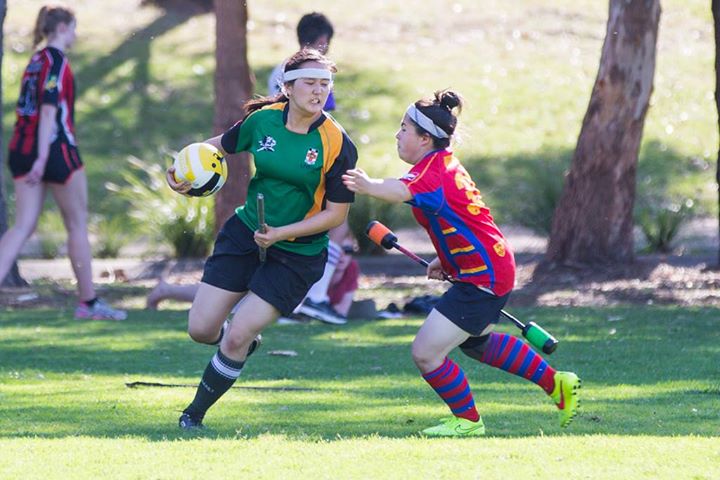
There are three notable clashes from October I have not yet mentioned. This is because not only were they the closest, but they were by far the most revealing. They also have a major bearing on how QUAFL will play out. UWS, Newcastle and Sydney, with their hugely disparate histories and approaches, have rather bottlenecked together just in time for QUAFL where what do you know, they’ve ended up all drawn together. If October is any indication, these will be three of the real classics of the tournament, and UWS may be in some trouble unless they can find another level. Of course they tend to usually do this and were without Christian Barquin at October, an influence that cannot be underestimated.
First up was the clash between UWS and Sydney which will always have spice in the near future thanks to last year’s QUAFL coup. But this year the Unspeakables hadn’t really gotten close to UWS, either in general or in direct combat. But the balance of power had shifted subtly on this occasion. It had not dramatically reversed, but UWS just found themselves unable to gain a firm foothold on what was a thoroughly even-keeled encounter. It was definitely the Unspeakables who looked the more likely early though, matching the UWS speed with their own similar reserves of Cameron Brown and Rob Wells led pace and Hannah Monty-matching nimble forward receivers, particularly the slick Carolyn Themel. But add to this, the X factor of size most notably provided in the form of man of the match Albornoz. By shortly after the ten minute mark Sydney were 40-20 up and with momentum, their lead reaching but crucially not exceeding thirty. With UWS less dominant than usual in the beater department without Barquin, it freed up the Unspeakable chasers to do their worst. Each of Sydney’s chasers were proving more adept at tackling, zoning and ultimate execution in general play, particular the final passes. These are all decidedly American hallmarks further developed since their spell at World Cup, but they’re skills that NSW teams are all increasingly finding necessary as we are immersed in the tackle game.
UWS can never be counted out though and as soon as the match started pushing towards the twenty-five minute mark you could sense there was danger for Sydney. A squad of ten is going to be hard pressed to hang on at the best of times, let alone one that likes to make the most of short bursts and regular rotations. Add the UWS fitness to that and the tables inevitably began to turn. By the time the snitch was back, the Thestrals had fought themselves back to an 80-70 lead and Stephen Butler’s catch sealed a thrilling come from behind 110-70 win.
Sydney had to then back up and face the Fireballs. Where UWS was an occasion that called for stepping up to the plate like they hadn’t so far this year, a grudge match against Newcastle is the opposite, for Sydney remain undefeated against them. After a slow and nervous start, it was Newcastle who took the clear ascendancy though, on the back of the unlikely beater pairing of Dameon Osborn and Desany Phanoraj. This new focus on beater tackle prowess reflects yet another distinct Americanisation permeating select elements of NSW play and is a necessity against the forward pressure of the Sydney beating.
Mitch McMahon was the only player to score over the first five minutes, but he’d powered his way through on three separate occasions. Luke Derrick again felt the need to shift to the quaffle game, to try and go some way to combating Newcastle’s physical dominance, and his goal put Sydney on the board on the sixth minute. It was all Newcastle otherwise though and by the lifting of the seeker floor they were 70-10 up and looked virtually home. But then down went the most experienced of all Fireballs, Desany Phanoraj, who crumpled sickeningly as an ankle gave way. With it, and without their guiding elder, away went Newcastle as a whole. The match was stopped for a whole twelve minutes as Phanoraj was treated, allowing the Unspeakables to fully refresh themselves.
After the restart it was a completely different match. The beater game transformed without Phanoraj’s inexperienced but impactful presence. With control firmly restored to the Sydney beaters, Newcastle had no way of stopping Nicholas Albornoz and Cameron Brown, whose twin hat-tricks turned a sixty point deficit into near parity. After a second stoppage for another key Newcastle injury, to Amy Ey who had taken up the key female beating slack since the first stoppage, finally it was time for the snitch catch. Newcastle’s lead had been wiped down to just ten, they’d lost two players for the day and amidst all the trauma were now totally haggard, but Liam Dawson saved the day with a match winning snitch catch.
In the 110-70 win, Newcastle showed they can put together clutch performances against quality opposition, but they also showed they are as susceptible to unforeseen drama and stress as ever. Sydney showed just how much fight they have to come from so far back and they will be closer to their best at QUAFL. The match showed just how good both teams can be but just how beatable both teams can also be and it showed the intrigue that can come from two progressive teams thinking creatively. But such was the match’s extenuating disruptiveness, there’s probably not much more that can be concluded.
So having lost all but Holly Cairncross from their female stocks, Newcastle were surely left unable to take the field against UWS. But against the odds, still the Fireballs fought on, fronting up against the speed and efficient zoning of UWS, perhaps the worse team to face a player down. Newcastle were decimated, down to seven total players, and still trying to pick up the emotional pieces of the catharsis and trauma that came from the costly Unspeakable win. UWS are always ruthless and were prepared for a presumptive spanking. But it was Newcastle’s playmaker Mortensen who struck first, then Cairncross and then Mitch McMahon. Hannah Monty brought a couple back but the speed merchants just could not stop the hulking power of Mortensen and McMahon, nor keep up with the precision of Cairncross at and behind the hoops. 30-0 became 50-10, then 60-30 in a remarkable and overpowering performance led by the downright heroic Mortensen. But UWS are never put to bed, particularly when you’ve run out of personnel to head them. Mortensen and McMahon continued to alternate strikes and keep Newcastle just clear, but the Thestrals slowly clawed their way back. Finally after twenty minutes they levelled proceedings at 90-90, then hit the front. By now the Fireballs were dead on their feet and with another injury reducing their number further, they had no choice but to concede the match before UWS drew further away.
UWS were credited with a snatch and so 130-90 was the final score, but it could not have escaped any observers who the best team had been early in the contest, back before fatigue took total hold, when Newcastle’s only handicap was the mere shortage of one entire person. But bias can only blind me so far. UWS still won the game, just as they did against Sydney too. The question for Newcastle, not for the first time, will be whether they can reproduce the kind of frenzied energy that the circumstances of this day created at a whim in a more controlled environment. They’ll need to in order to make that extra step up from their current perpetual position at the frustrating top edge of the second tier.
Photo Credit: Matt Hudson
So in conclusion, what can we draw from October and the wider year of Triwizard action as a whole? Well for all my profligate musing, really UNSW should probably still win. They are clearly the best team in the country and no matter how well others peak, it’s not like every team will suddenly be a match for them. Most won’t be, I suspect no more than one or two will be. But everyone will be a bit closer and quidditch is a fickle sport when you don’t have margins to play with.
Meanwhile, Newcastle and Sydney are well and truly on the up. They’re the teams I feel could go closest to upsetting UNSW, and they may just have reached if not overtaken UWS in the grand scheme of things. But that’s a speculative observation rather than a data-supported one, because UWS still keep winning. It’s irrelevant whether they were the best team in either of those two crunch matches (they weren’t), because they still won them. That’s the true strength of UWS, they know how to find ways of winning quidditch games. Can they beat UNSW? I don’t think so. But can they win QUAFL? Without question. You can never count UWS out and they aren’t a clear second in the country by accident.
As for the rest, a QUAFL champion is probably not among them but the nature of knockout quidditch means you can’t quite be sure. Macquarie are QUAFL specialists and for all the hubbub about the mystical dangers of Pool B, they could still easily get out of it, as could UTS from Pool A. Wollongong too will fancy their chances, having gotten the draw they would have hoped for. It will only take two wins for them to advance. They would both be upsets certainly, but they have beaten UTS before this year despite being largely outplayed, and have the spirit and structure to keep themselves in contests for long enough to make it possible. Stepping up from merely possible though, we have the Nargles who really should in all likelihood get out of Pool A relatively unscathed. Once any or all of these four teams can manage advancement, QUAFL glory is only three wins away; a little bit of good fortune, an extra dollop of crisp improvement and some sizeable servings of that addictive fruit momentum.
The finish line that is QUAFL comes at the end of a long and menacing main straight where the pack need only be close enough to slot into the slipstream and let nature do the rest. But how many teams were still close enough by the last turn in October? How quickly will the finish line sneak up on them? Then after all that, what final little power boost might the front-runners have in store to keep them clear and get them over the line?
